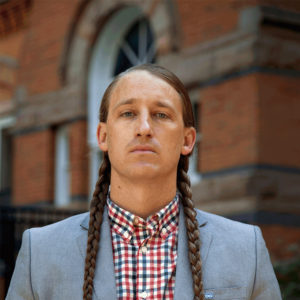ERIKETA COST
Life & Arts Editor
For Dylan Miner, being an artist is a multi-dimensional experience.
It’s bringing different sources, images, cultural and earthly references into one space to create a visceral realm.
Miner is the director of an American Indian and Indigenous Studies program at Michigan State College and also an associate professor.
Last week, during Fredonia’s Visiting Artist Program, Miner came to speak about all of these ideas. Wearing his hair in two long braids, a beaded hat and a necklace with imagery of a green plant with yellow roots, Miner spoke about his life and his work.
Miner’s work is about creating an emotional connection to every medium and tool. His deep-rooted connections to non-human, industrial-like objects is as natural as breathing for him.
The reason? His indigenous roots. His ancestors and history are key inspirations in Miner’s work.

Miner brings these lenses to the most simple and seemingly mundane objects — whether it’s copper, red cobble, pine needles or wooden platforms.
Miner was born and raised in Michigan. His ancestors came from a Georgian Bay Métis community, who fought against the Americans in the War of 1812 and ultimately were forced to move across the U.S.-Canada Border in 1828 and 1829.
“A lot of my work will reference indigenous thought and language word usage. When we think about contemporary art, we need to think of it as not always reproducing the dominant way of being in the world,” said Miner.
Artwork and creations from his ancestors are timeless for him — they’re a way he keeps his culture an integral part of his life.
An example of this is an octopus bag that his grandfather’s grandmother made.
“Octopus bags are common … in Metis culture, very similar to how Native people moving west would wear shoulder bags. These are made out of buckskin or wool, and then they’re beaded,” Miner said. “This one in particular is still in my family. It’s under my grandpa’s cousin’s bed.”
Weaving history into the present day ties in with the idea of artwork as an act of reclamation.
“A lot of my work is about reclamation and understanding history. It’s not as something in the past … it’s understanding our own situatedness, our own being here in this time and space as integrally connected with history, but also understanding that history is not somehow removed from the future,” he said.
Miner taught the audience the Ojibwe word, “Anikoubijuganagag.”
That basically refers to three generations: your great grandchildren, your great grandparents and your own.
“One of the things that is important about the work we do as artists, is often times were speculating, imagining trying to build and imagine that future in ways that are linked to the past,” he said.
In other words, the past, present and future can all be linked together in a circular relationship.
Additionally, Miner talked about activism in his work.
He showed a few graphics he created of Tina Fontaine and Colten Boushie, the indigenous people in Western Canada who were both killed. The graphics read “Justice for Colten,” and “Justice for Tina Fontaine.” The top read, “Colonial justice is the unending and systemic violence against indigenous people.”
“I bring these up because it’s always important to think about the way we use our work, in responding to political issues in the moment,” he said.
Griffin McPherson is one of the students who attended the lecture. He is a senior at Fredonia, but has a sophomore status in his drawing and painting major.
McPherson perceived Miner’s lecture as something that was perhaps more informative than emotional.
“My take away is that … the message he was trying to send is trying to get people to feel something about the history of the native people of this country. But I was not feeling what I think he wanted us to feel,” he said. “He was kind of delivering information through his art, and not really putting any emotion into it. And I find that to be like, kind of the crucial part of art. The point of art for me is connecting with people, through emotion and imagery, and he had the information there, which can have an emotional impact if its delivered correctly, but it just wasn’t.”
Max Lee, a junior B.F.A. sculpting major, had an easier time connecting.
“I thought his talk was actually super interesting. His ideas of free art and community really resonated with me, as I find myself trying to do the same thing,” said Lee. “His artwork and design speaks miles of influence of his indigenous heritage and get his point across in a clean and simple way.”
Lee especially loved Miner’s constant theme of copper.
“He makes art for the people, all people, and that’s a way of the future …”
You can check out more of Miner’s work and story at his Instagram @wiisaakodewinini, or his website, http://dylanminer.com/.
